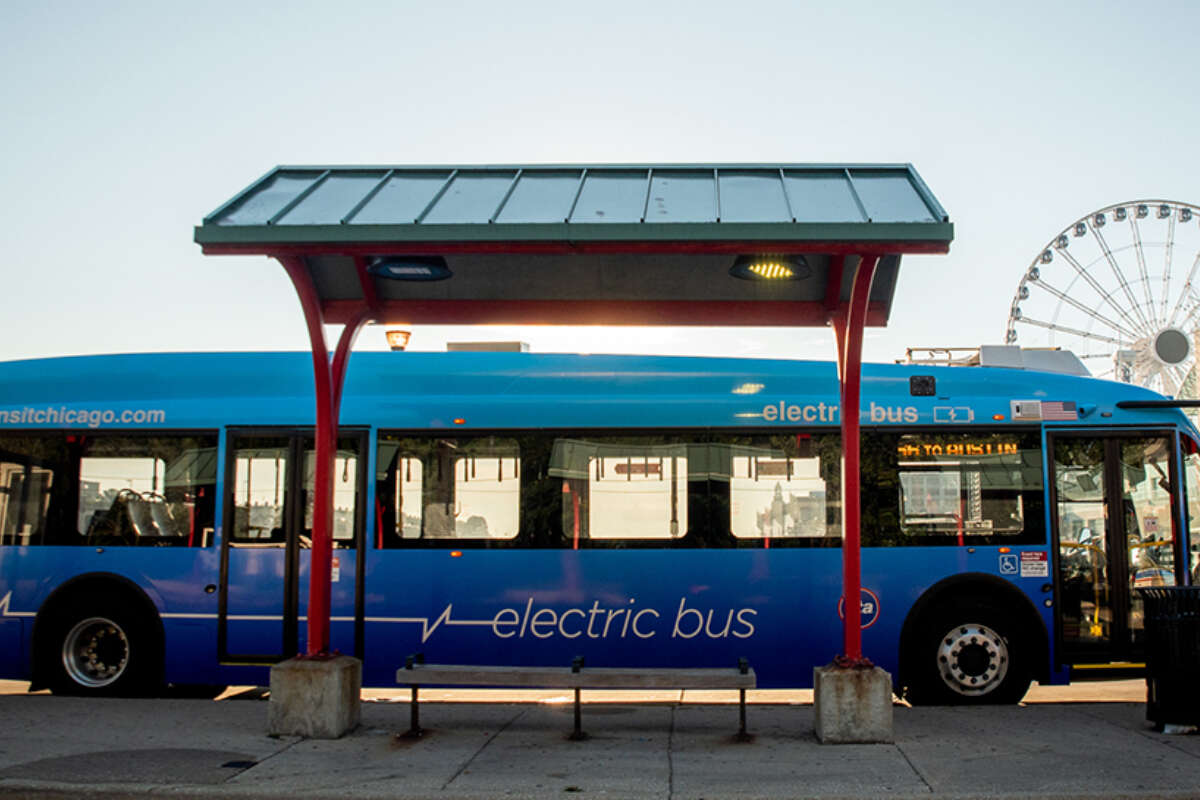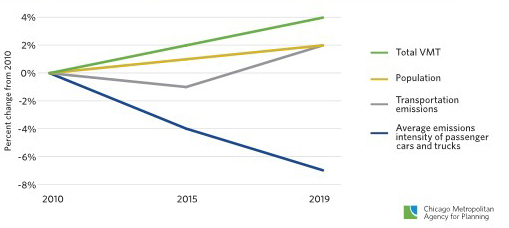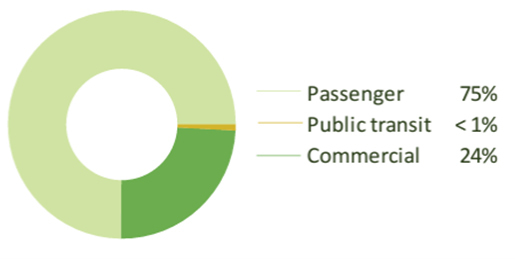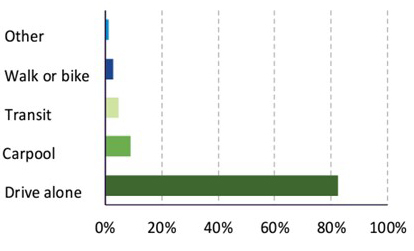Improved public transit is key to reducing transportation emissions
November 2, 2022
November 2, 2022

A new greenhouse gas (GHG) inventory shows reducing transportation emissions and meeting our regional climate goals requires getting more people riding public transit.
Last month the Chicago Metropolitan Agency for Planning (CMAP) released an updated catalogue of greenhouse gas emissions for the seven-county Chicago metro area. ON TO 2050, the comprehensive plan for northeastern Illinois, calls for the region to reduce greenhouse gas emissions by 80 percent, relative to 2005 levels, by 2050. This target aligns with the Paris Agreement’s goal of keeping global warming to below 2° Celsius (3.7° Fahrenheit).
According to CMAP, the region is not currently on track to meeting the target. Between 2010 and 2019, overall GHG emissions decreased by 9 percent — an average of 1 percent each year. To meet CMAP's goal, the region needs to increase that to 5 percent annually through 2050.
The data shows that, from 2010 to 2019, transportation emissions increased while emissions from all other sectors decreased. During this period fuel efficiency improved but transportation emissions still went up because there was more driving (increases in total and per capita vehicle miles traveled).

This data shows to reduce transportation emissions over the next 10 years the region will need to reduce driving. Even with fuel economy going up and more electric vehicles coming online, many gas and diesel cars and trucks will remain on Chicago area roads for the next decade. Making it easier for people to drive less and choose transit, walking, and biking more often will be key to making progress on regional climate goals.
Most transportation emissions in the Chicago area come from passenger cars and commercial trucks. In each of the CMAP region’s seven counties, emissions from passenger cars make up anywhere from 55 to 75 percent of total transportation emissions, while emissions from public transit make up less than one percent of the total. The remainder comes from commercial trucks.

Many of these emission generating trips in cars are people driving alone. Census data shows that in Cook County – the densest county in the region with the most public transit access – more than 60 percent of people drive to work alone. In DuPage, Kane, Kendall, Lake, McHenry, and Will Counties, where transit access is more limited, more than 80 percent of residents drive to work alone.

To reverse these trends the Chicago area needs to continue to regain transit ridership lost during the pandemic and ultimately grow ridership over the long-term.
Fortunately, unprecedented levels of federal and state funding are available to make significant investments in our transportation infrastructure. While additional federal and state support for transit is needed, particularly to cover an expected operating deficit in the coming years, a window of opportunity exists now to address longstanding needs. Planning is underway at the RTA, CTA, Metra, and Pace to help determine the most efficient and sustainable ways to invest these funds, in partnership with transportation departments across the state.
The RTA’s next strategic plan, which will be released for public comment later this year, features a range of advocacy and action steps that are key to reducing emissions and getting more people riding transit. It includes securing increased funding for transit operations and infrastructure so bus and train service is more frequent and reliable. It also includes advocating for state and federal leaders to reconsider the spending imbalance of transportation funds that favors highways over transit given the sustainability and equity benefits of transit.
The draft calls for the region to embrace more equitable transit-oriented development so people live and work closer to buses and trains and fewer trips require driving. Another goal calls for transit agencies to partner with roadway agencies to build more transit-friendly streets and advance networks of bus rapid transit.
While these goals will help reduce emissions by growing transit ridership and reducing driving, there’s also more transit agencies can do to reduce emissions from their own vehicles. Even though emissions from transit vehicles make up less than one percent of overall transportation emissions in the region, transit can strengthen its position at the center of a more sustainable network by electrifying.
This is why CTA and Pace are committed to converting to all-electric bus fleets by 2040. Both agencies are refining plans and beginning to purchase the equipment needed to transition and power their fleets and garages. Metra is piloting battery-powered locomotives that, if proven effective, could eventually be deployed across the system.
Still, the best opportunity for the region to reduce transportation emissions in the coming years is to reduce driving and get more people riding public transit, walking, and biking. The RTA's 2023 Regional Transit Strategic Plan envisions safe, reliable, accessible public transportation that connects people to opportunity, advances equity, and combats climate change. As the plan is finalized, there will be opportunities to join the coalition people and agency partners working to make this vision a reality. Sign up for the RTA's newsletter for updates and advocacy opportunities.
Subscribe to our Newsletter
Related Articles
 RTA to host Suburban Transit Summit to gather feedback and build support for improving service with new funding
RTA to host Suburban Transit Summit to gather feedback and build support for improving service with new funding
To gather feedback and build support for improving transit service with new, expanded funding, the RTA is hosting a half-day Suburban Transit Summit in Arlin...
October 21, 2024 RTA Citizens Advisory Board: Get to know Karl Gieseke
RTA Citizens Advisory Board: Get to know Karl Gieseke
Following through on a key recommendation from regional transit strategic plan Transit is the Answer, the RTA launched a newly expanded, rider-focused Citize...
October 15, 2024 Why Illinois legislators must reach a transit funding solution by spring 2025—and what happens if they don’t
Why Illinois legislators must reach a transit funding solution by spring 2025—and what happens if they don’t
Chicago’s regional transit system is facing a projected operating shortfall of more than $730 million annually—or nearly 20% of the regional operating budget...
October 9, 2024 CTA presents on Red Line Extension, Pace discusses network revitalization plan during presentations to RTA Board
CTA presents on Red Line Extension, Pace discusses network revitalization plan during presentations to RTA Board
CTA President Dorval Carter and Pace Executive Director Melinda Metzger presented midyear updates to the RTA Board of Directors during their meeting on Septe...
October 3, 2024 Transit Station Activations in Rogers Park, Woodlawn bring live music, pop-up plant-based festival for riders to enjoy
Transit Station Activations in Rogers Park, Woodlawn bring live music, pop-up plant-based festival for riders to enjoy
In May, the RTA announced more than $120,000 in funding for eight Transit Station Activation projects near CTA, Metra, and Pace stations and stops. The proje...
October 3, 2024 Illinois should learn from past transit funding crises and achieve sustainable funding
Illinois should learn from past transit funding crises and achieve sustainable funding
Public transit operations in the Chicago region have been chronically underfunded—particularly at the state level. Today, state funding makes up only 17% of ...
October 1, 2024